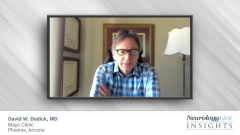
Gepants for Acute Migraine: Safety & Efficacy Data
Episodes in this series

David W. Dodick, MD: For rimegepant, the half-life is about 10, 12 hours. In the paper published in Lancet, there were about 23 secondary end points. The medication separated from placebo in 21 of 23 end points, including sustained relief and sustained pain-free rates.
We talked a little about recurrence before and how that frustrates patients. If you can take something and it sustains the benefit, whether it’s relief or it’s freedom from pain, that’s an advantage.
From an adverse-effect profile, rimegepant looked similar to placebo in terms of the adverse events that it caused. This gepant class of medication seems to be very favorably tolerated. But that’s in clinical trials. When that gets used in clinical practice, it is a different beast, right? Because we have patients who are sicker. We have patients with more medical comorbidities. We have patients on more medicines. And so regarding the results you get in clinical practice once you expose the drug to thousands to tens of thousands to hundreds of thousands of patients, you may start to see adverse events that weren’t seeing in the couple of thousand patients who were exposed to the drug in clinical trials. But certainly, from an adverse-effect and tolerability standpoint, these medications appear to be very favorably tolerated and were similar to placebo. There were no serious treatment-related adverse events, so there were no serious safety concerns that arose from the rimegepant trial.
We have seen 2 pivotal trials of ubrogepant. Very similar to rimegepant, both trials showed efficacy for the coprimary end points of freedom from pain in 2 hours and freedom from most bothersome symptoms, with pretty similar pain-free rates to rimegepant—around 20%, 21%. Those were very similar results, actually, but well tolerated with no serious safety concerns.
I will say that the restoration to normal function with ubrogepant, which was looked at as a secondary end point, was approximately double or a little more than double the pain-free response rates. That indicates that you don’t need to become pain-free to be restored to normal function or near-normal function. You could have relief of pain. You could still have mild pain but get relief of other associated symptoms and be able to get back to normal or near-normal functioning.
Although pain-free is an end point that’s used by regulatory agencies to get drugs approved, and it’s a mandatory requirement for companies and for investigators to use as a trial end point, it doesn’t necessarily reflect what we and our patients are actually after, which is getting them back to normal functioning, as we reviewed earlier. It’s worth keeping that in mind. If we can restore 40% to 45% of patients to near-normal or normal function when treating moderate or severe pain, perhaps we can do a lot better than that if we treat them while pain is mild.
Newsletter
Keep your finger on the pulse of neurology—subscribe to NeurologyLive for expert interviews, new data, and breakthrough treatment updates.







































